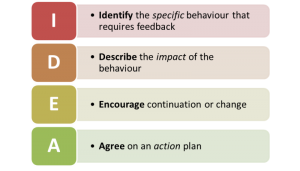Here’s an I.D.E.A. – Provide Effective Feedback!
A common challenge for many supervisors and managers when it comes to managing people is providing effective feedback. This is particularly the case where they need to give feedback to a team member who is presently not meeting expectations and/or where they have done something wrong.
Some supervisors and managers become paralysed by fear that the recipient of the feedback may not take it well – they might be upset, your current good relationship might be damaged or, even worse, they might argue against the feedback and become openly hostile toward you. Other supervisors and managers have no trouble telling people exactly what they have done wrong and what they need to do to improve, but they deliver the news in a way that causes people to react negatively, with the result that their efforts to improve the situation result in the recipient becoming angry and/or disengaged. The I.D.E.A. model essentially provides a simple, easy-to-remember structure to help you prepare for and manage potentially difficult conversations. An overview of the model is presented below:  Here are some key points to help you make best use of the model:
Here are some key points to help you make best use of the model:
– Spend some time preparing for the discussion. Sit down and plan how you want the conversation to go. Use the model to identify the points you want to work through and write them down. Using the model will help you stay on track, ensure you say what you need to say and don’t get caught up in your own emotions or distracted by the responses or emotions of your team member.
– Identify – it’s important that you provide specific feedback so that the recipient understands precisely what you need them to do differently. “Your customer service is not at the level required” is simply not specific enough. Is it the way they greet customers that is the problem? The time taken to respond to customers? Their personal presentation? The way they handle customer complaints/concerns? Describe the specific problem(s) and clarify your specific expectations.
– Describe the impact – This can be really powerful. Why is it important that they correct/change their behaviour? If you don’t adequately communicate the impact they may just think you are being “picky” for no good reason. If a person is frequently 10 minutes late for work for example, identify and describe the potential impacts on other team members who need to carry a bigger load, the impact on the revenue/expenses of the business, the detrimental impact on customer service etc…
– Encourage continuation or change – Clearly indicate that you need the behaviour to continue (in the case of positive feedback) or stop or change (in the case of corrective feedback).
– Agree on an action plan – Particularly in the case of corrective feedback, be sure to cover the “where to from here?” question. This may include establishing a period of review, setting a date for a further meeting, and/or providing some coaching, training or other support for example.
Sure, this isn’t a magic wand and some of the conversations you need to have may still be uncomfortable, but armed with the I.D.E.A. model, a bit of preparation and some practice, you should find it at least a bit easier to provide effective feedback.















